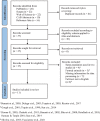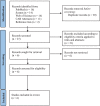Disentangling the role of wild birds in avian metapneumovirus (aMPV) epidemiology: A systematic review and meta-analysis
- PMID: 35960706
- PMCID: PMC10086952
- DOI: 10.1111/tbed.14680
Disentangling the role of wild birds in avian metapneumovirus (aMPV) epidemiology: A systematic review and meta-analysis
Abstract
Given the avian metapneumovirus (aMPV) disease burden in poultry worldwide and the evidence of a possible role played by wild birds in the virus epidemiology, the present study summarizes aMPV serological and molecular data on free-ranging avifauna available in the literature by conducting a systematic review and meta-analysis. A computerized literature research was performed on PubMed, Scopus, CAB Direct and Web of Science to identify relevant publications across the period 1990-2021, along with the screening of reference lists. A random-effect model was applied to calculate pooled prevalence estimates with 95% confidence intervals. The inconsistency index statistic (I2 ) was applied to assess between-study heterogeneity. Subgroup analyses for molecular studies only were performed according to geographical area of samplings, taxonomic order, genus and migration patterns of the birds surveyed. A total of 11 publications on molecular surveys and 6 on serological ones were retained for analysis. The pooled molecular prevalence was 6% (95% CI: 1-13%) and a high between-study heterogeneity was detected (I2 = 96%, p < .01). Moderator analyses showed statistically significant differences according to geographical area studied, taxonomic order and genus. Concerning serological prevalence, a pooled estimate of 14% (95% CI: 1-39%), along with a high between-study heterogeneity, was obtained (I2 = 98%, p < .01). Moderator analysis was not performed due to the scarcity of eligible serological studies included. Overall, molecular and serological evidence suggests that some wild bird taxa could play a role in aMPV epidemiology. Particularly, wild ducks, geese, gulls and pheasants, according to scientific contributions hereby considered, proved to be susceptible to aMPV, and due to host ecology, may act as a viral carrier or reservoir. Further surveys of wild birds are encouraged for a better comprehension of the poultry/wild bird interface in aMPV epidemiology and for better characterizing the virus host breadth.
Keywords: avian metapneumovirus; meta-analysis; seroprevalence; systematic review; viroprevalence; wild birds.
© 2022 The Authors. Transboundary and Emerging Diseases published by Wiley-VCH GmbH.
Conflict of interest statement
The authors declare that they have no competing interests.
Figures






Similar articles
-
Avian metapneumovirus subtype C in Wild Waterfowl in Ontario, Canada.Transbound Emerg Dis. 2018 Aug;65(4):1098-1102. doi: 10.1111/tbed.12832. Epub 2018 Feb 18. Transbound Emerg Dis. 2018. PMID: 29457370
-
Avian metapneumovirus subtype B in a Northern shoveler (Spatula clypeata) wintering in Italy: implications for the domestic-wild bird interface?Avian Pathol. 2025 Jun;54(3):351-358. doi: 10.1080/03079457.2024.2441175. Epub 2025 Jan 3. Avian Pathol. 2025. PMID: 39749584
-
Infectious bursal disease virus in free-living wild birds: A systematic review and meta-analysis of its sero-viroprevalence on a global scale.Transbound Emerg Dis. 2022 Sep;69(5):2800-2815. doi: 10.1111/tbed.14433. Epub 2021 Dec 29. Transbound Emerg Dis. 2022. PMID: 34918482
-
Serological survey of avian metapneumovirus in vaccinated and unvaccinated broiler chickens in Hong Kong.Trop Anim Health Prod. 2023 Apr 29;55(3):179. doi: 10.1007/s11250-023-03592-6. Trop Anim Health Prod. 2023. PMID: 37119359
-
Zoonotic Origins of Human Metapneumovirus: A Journey from Birds to Humans.Viruses. 2022 Mar 25;14(4):677. doi: 10.3390/v14040677. Viruses. 2022. PMID: 35458407 Free PMC article. Review.
Cited by
-
Salmonella enterica Serovar Infantis in Broiler Chickens: A Systematic Review and Meta-Analysis.Animals (Basel). 2024 Nov 28;14(23):3453. doi: 10.3390/ani14233453. Animals (Basel). 2024. PMID: 39682418 Free PMC article. Review.
-
Introduction of Avian metapneumovirus subtype A to the United States: molecular insights and implications.Front Microbiol. 2024 Jul 5;15:1428248. doi: 10.3389/fmicb.2024.1428248. eCollection 2024. Front Microbiol. 2024. PMID: 39035438 Free PMC article.
-
Infectious Laryngotracheitis Virus and Avian Metapneumovirus: A Comprehensive Review.Pathogens. 2025 Jan 10;14(1):55. doi: 10.3390/pathogens14010055. Pathogens. 2025. PMID: 39861016 Free PMC article. Review.
-
Wild Birds as Drivers of Salmonella Braenderup and Multidrug Resistant Bacteria in Wetlands of Northern Italy.Transbound Emerg Dis. 2024 Jan 12;2024:6462849. doi: 10.1155/2024/6462849. eCollection 2024. Transbound Emerg Dis. 2024. PMID: 40303189 Free PMC article.
-
Tracing the Flight: Investigating the Introduction of Avian Metapneumovirus (aMPV) A and B.Animals (Basel). 2024 Jun 14;14(12):1786. doi: 10.3390/ani14121786. Animals (Basel). 2024. PMID: 38929405 Free PMC article.
References
-
- Belant, J. L. , Ickes, S. K. , & Seamans, T. W. (1998). Importance of landfills to urban‐nesting herring and ring‐billed gulls. Landscape and Urban Planning, 43. 10.1016/S0169-2046(98)00100-5 - DOI
-
- Bennett, R. S. , McComb, B. , Shin, H. J. , Njenga, M. K. , Nagaraja, K. V. , & Halvorson, D. A. (2002). Detection of avian pneumovirus in wild Canada (Branta canadensis) and blue‐winged teal (Anas discors) geese. Avian Diseases, 46, 1025–1029. 10.1637/0005-2086(2002)046[1025:DOAPIW]2.0.CO;2 - DOI - PubMed
-
- Bennett, R. S. , Nezworski, J. , Velayudhan, B. T. , Nagaraja, K. V. , Zeman, D. H. , Dyer, N. , Graham, T. , Lauer, D. C. , Njenga, M. K. , & Halvorson, D. A. (2004). Evidence of avian pneumovirus spread beyond Minnesota among wild and domestic birds in central North America. Avian Diseases, 48, 902–908. 10.1637/7208-051804R - DOI - PubMed
Publication types
MeSH terms
LinkOut - more resources
Full Text Sources

